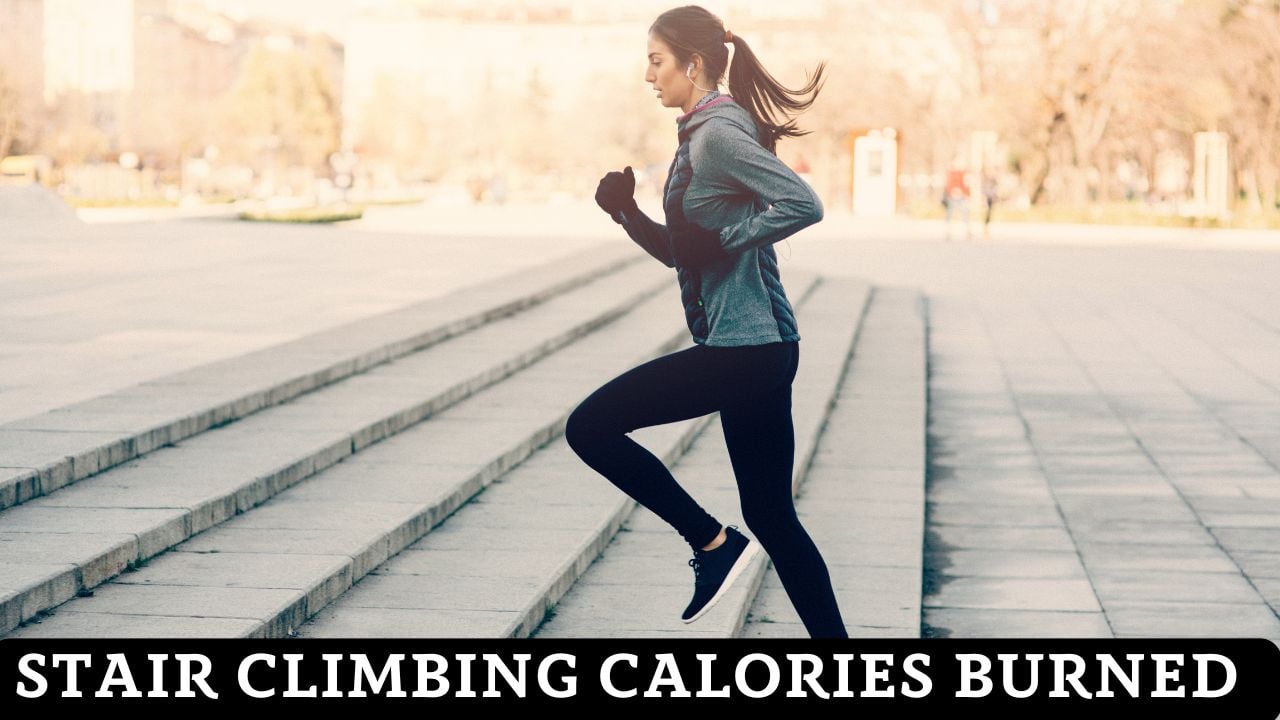Stair Climbing Calories Burned Calculator

How Many Calories Does Stair Climbing Burn?
Stair climbing burns between 300-850 calories per hour depending on climbing speed, step pattern (single vs double steps), body weight, and whether you’re carrying additional load. A moderate-paced stair climb burns approximately 400-600 calories per hour for most people.
Stair climbing is one of the most efficient calorie-burning exercises because it combines cardio work with resistance training against gravity. Each step requires lifting your entire body weight vertically, engaging major leg muscles while elevating heart rate significantly.
Research demonstrates that regular stair climbing significantly improves cardiovascular fitness and burns substantial calories. Our calculator uses validated MET values from the Compendium of Physical Activities to provide accurate stair climbing calorie estimates. For horizontal cardio, explore our walking calorie calculator.
The Science Behind Stair Climbing Calorie Burn
Understanding Each Component:
- Time: Duration of your stair climbing session in minutes
- MET Value: Metabolic Equivalent from Compendium (4.5-12.0 for stair climbing activities)
- 3.5: Standard oxygen consumption constant (ml/kg/min at rest)
- Weight: Your body weight in kilograms
- 200: Conversion factor to calculate calories
💡 Practical Example:
Person: 70 kg (154 lbs)
Duration: 20 minutes
Activity: Regular stair climbing (general pace)
MET Value: 6.8 (Compendium Code 17131)
Calculation:
(20 × 6.8 × 3.5 × 70) ÷ 200 = 166 calories
MET Values of Stair Climbing
Our calculator uses MET values from the Compendium of Physical Activities, which provides scientifically validated energy expenditure data for stair climbing:
Slow Pace: 4.5 METs – Casual climbing, one step at a time with rest breaks.
General Climbing: 6.8 METs – Steady continuous climbing at moderate pace.
Fast Single Steps: 9.3 METs – Rapid ascent, one step at a time, vigorous effort.
Two Steps at Time: 7.5 METs – Taking double steps, moderate to vigorous intensity.
Using Ladder: 8.0 METs – Climbing vertical ladder or similar apparatus.
Ascending/Descending: 7.5 METs – Combined up and down stair climbing.
📊 Load Carriage Impact on Calorie Burn
Carrying weight while climbing stairs dramatically increases calorie expenditure. The Compendium provides specific data on load carriage upstairs:
Light Load (1-15 lbs): Base MET 5.5 – approximately 10-15% increase over no load.
Moderate Load (16-24 lbs): MET value of 6.0 – approximately 20% increase.
Heavy Load (25-49 lbs): MET value of 8.0 – approximately 40% increase over baseline.
Very Heavy (50-74 lbs): MET value reaches 10.0 – approximately 60% more calories.
Extreme Load (>74 lbs): MET value of 12.0 – approximately 80% increase, nearly doubling calorie burn.
The energy cost increases approximately 5-8% for each additional 10 pounds carried. For loaded training, check our rucking calculator.
🎯 Factors Affecting Stair Climbing Calorie Burn
Multiple factors determine total stair climbing energy expenditure:
Climbing Speed: The primary factor. Fast climbing (9.3 METs) burns over twice as many calories as slow climbing (4.5 METs). Each additional step per minute increases calorie burn by approximately 1-2%.
Step Pattern: Taking two steps at once (7.5 METs) requires more power per rep but fewer total reps, resulting in similar or slightly higher calorie burn than single steps at the same speed.
Body Weight: Heavier climbers burn significantly more calories. A 20 kg (44 lb) weight difference changes calorie burn by 30-35% because you’re lifting more mass against gravity with every step.
Carried Load: As noted, carrying weight dramatically increases energy cost. Even a light backpack (10 lbs) can add 10-15% more calories.
Continuous vs Intermittent: Non-stop climbing maintains elevated heart rate, while taking breaks reduces average calorie burn per minute but may allow longer total climbing duration.
Stair Climbing Calorie Burn by Activity Type
| Stair Climbing Activity | MET Value | Calories/Hour (70kg) | Description |
|---|---|---|---|
| Slow Pace | 4.5 | 331 cal/hr | Casual climb, rest breaks |
| General Climbing | 6.8 | 500 cal/hr | Steady moderate pace |
| Two Steps at Time | 7.5 | 551 cal/hr | Double step pattern |
| Ascending/Descending | 7.5 | 551 cal/hr | Up and down combined |
| Using Ladder | 8.0 | 588 cal/hr | Vertical ladder climbing |
| Fast Single Steps | 9.3 | 683 cal/hr | Rapid vigorous ascent |
| With Light Load (1-15 lbs) | 5.5 | 404 cal/hr | Carrying 1-15 lb load |
| With Moderate Load (16-24 lbs) | 6.0 | 441 cal/hr | Carrying 16-24 lb load |
| With Heavy Load (25-49 lbs) | 8.0 | 588 cal/hr | Carrying 25-49 lb load |
| With Very Heavy (50-74 lbs) | 10.0 | 735 cal/hr | Carrying 50-74 lb load |
| With Extreme Load (>74 lbs) | 12.0 | 882 cal/hr | Carrying >74 lb load |
Note: MET values from the Compendium of Physical Activities. Calories calculated for 70 kg (154 lb) person. Actual burn varies with fitness level, stair height, and climbing technique. Load carriage can double calorie burn.
Stair Climbing Calories by Duration
⏱️ Time-Based Calorie Estimates
Understanding how duration affects calorie burn helps plan effective stair climbing workouts. These estimates use general stair climbing (6.8 METs) as the baseline.
For complete fitness planning, explore our BMR calculator and TDEE calculator for total energy expenditure.
| Duration | 130 lb (59 kg) | 150 lb (68 kg) | 175 lb (79 kg) | 200 lb (91 kg) | 225 lb (102 kg) | 250 lb (113 kg) |
|---|---|---|---|---|---|---|
| 5 mins | 42 cal | 48 cal | 56 cal | 64 cal | 72 cal | 80 cal |
| 10 mins | 83 cal | 96 cal | 112 cal | 128 cal | 144 cal | 160 cal |
| 15 mins | 125 cal | 144 cal | 168 cal | 192 cal | 216 cal | 240 cal |
| 20 mins | 166 cal | 192 cal | 224 cal | 256 cal | 288 cal | 320 cal |
| 30 mins | 250 cal | 288 cal | 336 cal | 384 cal | 432 cal | 480 cal |
| 45 mins | 374 cal | 432 cal | 504 cal | 576 cal | 648 cal | 720 cal |
| 60 mins | 499 cal | 576 cal | 672 cal | 768 cal | 864 cal | 960 cal |
Note: Values based on general stair climbing (6.8 METs, Code 17131). Fast climbing can increase values by 35-40%, while carrying weight can double calorie burn. Slow pace reduces values by approximately 35%.
Stair Climbing Calorie Calculator FAQs
❓ How accurate is the stair climbing calorie calculator?
Our calculator uses the scientifically validated formula: Calories = (Time × MET × 3.5 × Weight) ÷ 200, combined with MET values directly from the [Compendium of Physical Activities](https://pacompendium.com/walking/). This provides accuracy within 10-15% for most individuals, comparable to laboratory measurements. The Compendium data is based on actual metabolic measurements and represents the gold standard for physical activity energy expenditure.
🏃 How much do carrying weights increase calorie burn?
Carrying weight dramatically increases stair climbing calorie burn. According to Compendium data: a light load of 1-15 lbs (Code 17026) increases MET from 6.8 to 5.5 (+10-15% for the extra effort), moderate load of 16-24 lbs (Code 17027) reaches 6.0 METs (+20%), heavy load of 25-49 lbs (Code 17028) jumps to 8.0 METs (+40%), and extreme loads over 74 lbs (Code 17030) can reach 12.0 METs, nearly doubling calorie burn. The energy cost increases approximately 5-8% for every additional 10 pounds carried.
⚡ Does stair climbing speed significantly affect calories?
Yes, dramatically. Based on Compendium data: slow pace (4.5 METs) burns 331 cal/hour, general/moderate pace (6.8 METs) burns 500 cal/hour (+51%), and fast single-step climbing (9.3 METs) burns 683 cal/hour (+106% vs slow). This means fast climbing can more than double your calorie burn compared to slow climbing. Speed is the single most impactful variable you control during stair climbing workouts. Build leg strength with our leg strengthening exercises.
🎯 Should I take single steps or double steps?
Both are effective, with different benefits. Single steps at fast pace (9.3 METs, Code 17134) burn the most calories per minute (683 cal/hour), making them ideal for maximum calorie burn and cardio intensity. Double steps (7.5 METs, Code 17136) burn 551 cal/hour, which is still excellent, while also providing more power training for glutes and hamstrings. For variety and comprehensive training, alternate between both patterns. Mixing tempos also prevents overuse injuries and keeps workouts engaging.
🏋️♂️ How does stair climbing compare to other cardio?
Stair climbing offers unique advantages. Moderate stair climbing (6.8 METs) burns more than brisk walking (4.0 METs) and similar to jogging (7.0 METs), but with the added benefit of resistance training for legs and glutes. Fast stair climbing (9.3 METs) rivals running (8-10 METs) for calorie burn. Additionally, stair climbing is lower impact than running while providing significant leg strengthening benefits. Compare with our running calculator and walking calculator.
📊 Can I use stair climbing for weight loss?
Absolutely! Stair climbing is extremely effective for weight loss. A 20-minute moderate stair climbing session burns 200-300 calories, while intensive 30-minute sessions can burn 400-600 calories. Regular stair climbing builds muscle mass (which increases resting metabolic rate) while burning substantial calories. For optimal weight loss, combine stair climbing with proper nutrition tracking using our daily calorie calculator and weight loss workout plans. Track progress with our weight loss percentage calculator.
🏃 Training & Performance Disclaimer
Consult with healthcare professionals, certified trainers, or sports medicine specialists before beginning intensive stair climbing programs, especially if you have pre-existing knee problems, cardiovascular conditions, or joint issues. Start with shorter duration and lower intensity, gradually progressing to more challenging workouts. This tool is for educational and informational purposes only.
Related
- Weightlifting Calories Burned Calculator
- Boxing Calories Burned Calculator
- Plank Calories Burned Calculator
- Burpee Calories Burned Calculator
- Crunches Calories Burned Calculator
- Sit-Up Calories Burned
- Zumba Calories Burned Calculator
- Pull Up Calories Burned Calculator
- Push-Up Calories Burned Calculator
- Home Activities Calories Burned Calculator
- Exercise Calories Burned Calculator
- Running Calorie Calculator
- Walking Calorie Burned Calculator
References
- Conger SA, Herrmann SD, Willis EA, Nightingale TE, Sherman JR, Ainsworth BE. 2024 Wheelchair Compendium of Physical Activities: An update of activity codes and energy expenditure values. Journal of Sport and Health Science, 2024;13(1): 18-23.
- Herrmann SD, Willis EA, Ainsworth BE, Barreira TV, Hastert M, Kracht CL, Schuna Jr. JM, Cai Z, Quan M, Tudor-Locke C, Whitt-Glover MC, Jacobs DR. 2024 Adult Compendium of Physical Activities: A third update of the energy costs of human activities. Journal of Sport and Health Science, 2024;13(1): 6-12.
- Whittaker AC, Eves FF, Carroll D, Roseboom TJ, Ginty AT, Painter RC, de Rooij SR. Daily stair climbing is associated with decreased risk for the metabolic syndrome. BMC Public Health. 2021 May 14;21(1):923. doi: 10.1186/s12889-021-10965-9. PMID: 33990186; PMCID: PMC8122558.
- Ghosal AM, Chandrasekaran B. Stair-climbing interventions on cardio-metabolic outcomes in adults: A scoping review. J Taibah Univ Med Sci. 2023 Nov 1;19(1):136-150. doi: 10.1016/j.jtumed.2023.10.003. PMID: 38021217; PMCID: PMC10656261.
- Stenling, A., Moylan, A., Fulton, E., & Machado, L. (2019). Effects of a Brief Stair-Climbing Intervention on Cognitive Performance and Mood States in Healthy Young Adults. Frontiers in Psychology, 10, 481303. https://doi.org/10.3389/fpsyg.2019.02300

Manish is a NASM-certified fitness and nutrition coach with over 10 years of experience in weight lifting and fat loss fitness coaching. He specializes in gym-based training and has a lot of knowledge about exercise, lifting technique, biomechanics, and more.
Through “Fit Life Regime,” he generously shares the insights he’s gained over a decade in the field. His goal is to equip others with the knowledge to start their own fitness journey.
